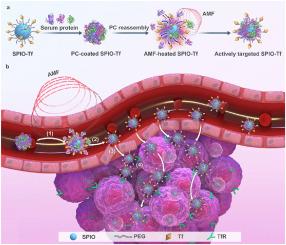Enhanced tumor-targeting ability of transferrin-functionalized magnetic nanoparticles by in vivo AMF stimulation
IF 12.8
1区 医学
Q1 ENGINEERING, BIOMEDICAL
引用次数: 0
Abstract
The protein corona formed on the surface of ligand-functionalized nanoparticles has been associated with the loss of targeting capability of the nanoparticles in vivo. Here, we developed a remote magnetothermal stimulation approach to regulate the in vivo active-targeting capability of transferrin (Tf)-functionalized magnetic nanoparticles (SPIO-Tf). This technique harnesses the heat dissipation by the magnetic nanoparticles in response to alternating magnetic fields to re-expose buried Tf on the nanoparticle surface, thereby restoring its binding function. SPIO-Tf with different grafting densities were prepared and in vitro experiments reveal that AMF stimulation of SPIO-Tf significantly improved its targeting ability to A549 cells in serum-rich environments. In vivo experiments also exhibit a 2.68-fold greater accumulation of magnetothermal-stimulated SPIO-Tf in solid tumors. Moreover, our approach is applicable to various SPIO-Tf formulations with different PEG molecular weights, and antibodies-conjugated SPIO. Overall, this study establishes a versatile, safe and potent strategy to tackle the negative impact of protein corona on the targeting ability of ligand-decorated magnetic nanoparticles in vivo, with promising implications for enhancing the effectiveness of diagnostic and therapeutic interventions across a range of diseases.

通过体内AMF刺激增强转铁蛋白功能化磁性纳米粒子的肿瘤靶向能力
配体功能化纳米粒子表面形成的蛋白电晕与纳米粒子在体内失去靶向能力有关。在这里,我们开发了一种远程磁热刺激方法来调节转铁蛋白(Tf)功能化磁性纳米粒子(SPIO-Tf)的体内活性靶向能力。该技术利用磁性纳米粒子在交变磁场作用下的散热来重新暴露纳米粒子表面埋藏的转铁蛋白,从而恢复其结合功能。我们制备了不同接枝密度的 SPIO-Tf,体外实验显示,在血清丰富的环境中,AMF 对 SPIO-Tf 的刺激显著提高了其对 A549 细胞的靶向能力。体内实验也显示,磁热刺激的 SPIO-Tf 在实体瘤中的累积量增加了 2.68 倍。此外,我们的方法还适用于不同 PEG 分子量的 SPIO-Tf 制剂和抗体结合的 SPIO。总之,这项研究建立了一种多功能、安全且有效的策略,以解决蛋白质电晕对配体装饰的磁性纳米粒子在体内靶向能力的负面影响,这对提高各种疾病的诊断和治疗干预效果具有重要意义。
本文章由计算机程序翻译,如有差异,请以英文原文为准。
求助全文
约1分钟内获得全文
求助全文
来源期刊

Biomaterials
工程技术-材料科学:生物材料
CiteScore
26.00
自引率
2.90%
发文量
565
审稿时长
46 days
期刊介绍:
Biomaterials is an international journal covering the science and clinical application of biomaterials. A biomaterial is now defined as a substance that has been engineered to take a form which, alone or as part of a complex system, is used to direct, by control of interactions with components of living systems, the course of any therapeutic or diagnostic procedure. It is the aim of the journal to provide a peer-reviewed forum for the publication of original papers and authoritative review and opinion papers dealing with the most important issues facing the use of biomaterials in clinical practice. The scope of the journal covers the wide range of physical, biological and chemical sciences that underpin the design of biomaterials and the clinical disciplines in which they are used. These sciences include polymer synthesis and characterization, drug and gene vector design, the biology of the host response, immunology and toxicology and self assembly at the nanoscale. Clinical applications include the therapies of medical technology and regenerative medicine in all clinical disciplines, and diagnostic systems that reply on innovative contrast and sensing agents. The journal is relevant to areas such as cancer diagnosis and therapy, implantable devices, drug delivery systems, gene vectors, bionanotechnology and tissue engineering.
 求助内容:
求助内容: 应助结果提醒方式:
应助结果提醒方式:


